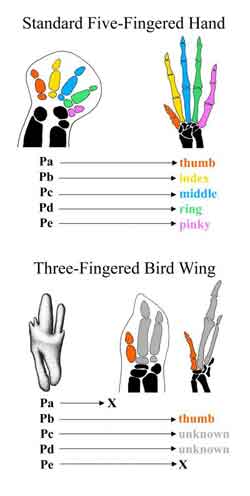Yale researchers solve mystery of disappearing bird digit

A genomic analysis shows that precursor cells pb that form index finger in five-fingered vertebrates can form the "thumb" (in orange) or first digit in three-digit bird wing. Credit: courtesy Yale University<br>
Yale scientists now have a good handle on how these developmental changes are orchestrated in the embryo, but there is still one outstanding debate on birds: Which digits are they: a thumb with index and middle fingers, or the index, middle and ring fingers?
In five-digit vertebrates, the thumb comes from the precursor stem cells labeled pa. While birds have a digit that looks like a thumb, pa precursor cells die off during development and never produce a digit in adults. As a result, scientists have wondered whether precursor cells in pb can make a thumb.
Yale scientists have completed a genomic analysis of birds that reveals the answer (shown in orange on illustration). It is a hands down “yes” — even though the first bird digit develops where the index finger on a five-finger vertebrae should be.
The results are published online Sept. 4 in the journal Nature. Authors are Zhe Wang, Rebecca L. Young, Huiling Xue, and Gunter P. Wagner from the Department of Ecology and Evolutionary Biology.
Media Contact
More Information:
http://www.yale.eduAll latest news from the category: Life Sciences and Chemistry
Articles and reports from the Life Sciences and chemistry area deal with applied and basic research into modern biology, chemistry and human medicine.
Valuable information can be found on a range of life sciences fields including bacteriology, biochemistry, bionics, bioinformatics, biophysics, biotechnology, genetics, geobotany, human biology, marine biology, microbiology, molecular biology, cellular biology, zoology, bioinorganic chemistry, microchemistry and environmental chemistry.
Newest articles

Superradiant atoms could push the boundaries of how precisely time can be measured
Superradiant atoms can help us measure time more precisely than ever. In a new study, researchers from the University of Copenhagen present a new method for measuring the time interval,…

Ion thermoelectric conversion devices for near room temperature
The electrode sheet of the thermoelectric device consists of ionic hydrogel, which is sandwiched between the electrodes to form, and the Prussian blue on the electrode undergoes a redox reaction…

Zap Energy achieves 37-million-degree temperatures in a compact device
New publication reports record electron temperatures for a small-scale, sheared-flow-stabilized Z-pinch fusion device. In the nine decades since humans first produced fusion reactions, only a few fusion technologies have demonstrated…





















